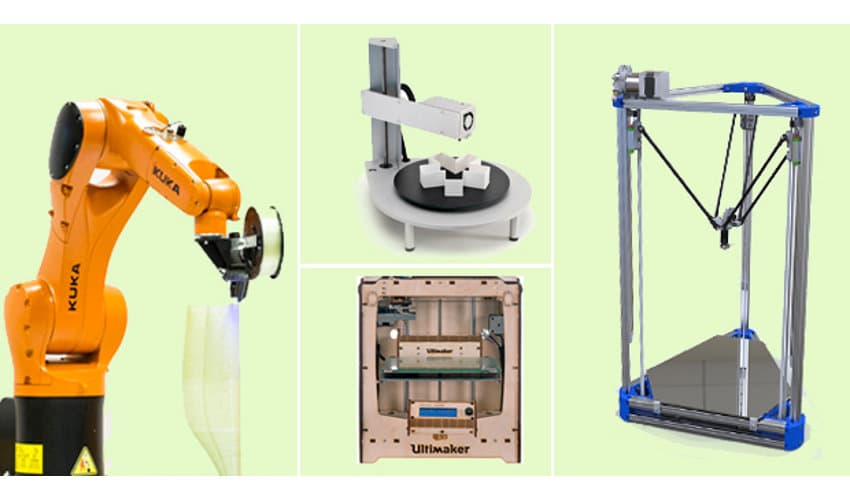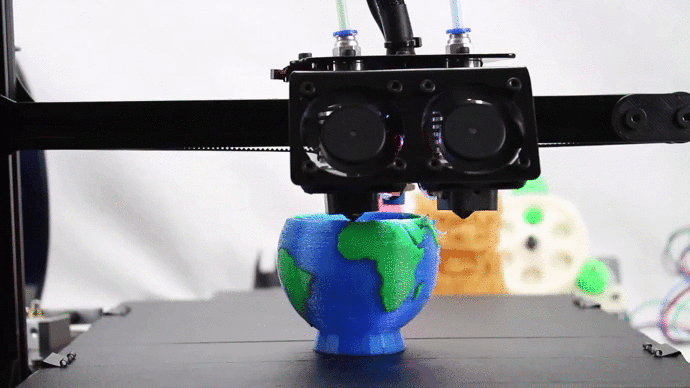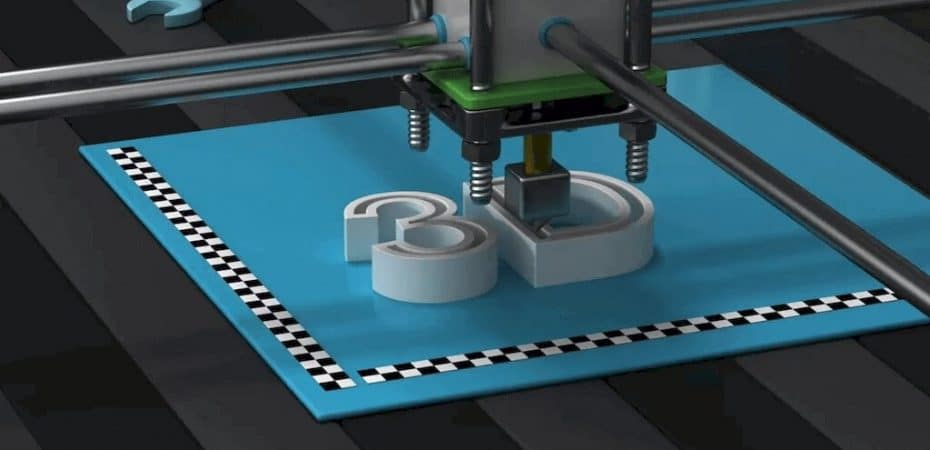3D Printing is now one of the fastest-growing fields due to its uncountable advantages and unimaginable potentials. From developing prototypes to creating replacement parts, from reconstructing fossils to designing customized consumer products, the 3D printing technology uses are expanding each day.
3D printing technology is now playing a significant role in nearly all major industries across the globe, and its impact will keep on growing as more and more people and industries gain access to the amazing 3D printing technology.
Table of Contents
What are 3D printers?

3D printers use computer-aided design (CAD) to produce three-dimensional objects. The 3D printed items are made from a variety of materials, including powders, to molten plastic.
Also referred to as – “additive manufacturing,” 3D Printing involves layers of different materials to produce a three-dimensional object. The commonly used layering materials include composites, plastic, and bio-materials; these materials are used to create items of different shapes, sizes, colors, and rigidity.
These printers act similar to 2D inkjet printers and used a layering method to produce the desired design and object. 3D printers create objects from the ground up and stack layers on top of each other until the desired object shape is achieved.
One of the biggest reasons behind these printers’ widespread popularity is the extreme versatility and flexibility of creating various customized objects. From printing consumer objects from plastic-like sunglasses, phone cases, bike handles to utilizing carbon fiber and metallic powders to print extremely strong industrial products – 3D printers have endless possibilities.
How Do 3D Printers Work?

As mentioned above, 3D printers are from the additive manufacturing family, and they utilize a similar printing method as the traditional inkjet printers. 3D Printing is a revolutionary technology that uses a combo of hi-tech software, powder-like manufacturing materials, and precision tools to produce 3D objects from scratch.
Unlike traditional office printers, 3D printers use computer-aided design (CAD) to produce three-dimensional objects. The 3D printed items are made from a variety of materials, including powders, to molten plastic.
The process of 3D Printing begins with making a digital 3D model, which you can develop of download from a 3D model repository. If you are creating it yourself, you will use a 3D scanner, haptic device, app, code, or a 3D modeling software.
3D Modeling Software
There are various 3D modeling software tools that you can use, including software designed especially for industrial use that costs thousands of dollars per year. Nonetheless, there are also open-source software that are available for free.
If you are a new to 3D printing technology and wish to dip your toes in the world of 3D Printing, then we recommend free software that works in your browser. You can find beginner-friendly options that come with instructions and tips to help you along.
Once the three-dimensional model is finished, you will prepare the file to send it to the 3D printer; this process is called slicing.
Slicing
Slicing is the process of dividing a 3D model into thin horizontal layers using a slicing software. After your file is sliced, it is ready to be sent to the 3D printer through the internet, USB, or SD. The model is then printed as per the sliced layers.
A built-in slicer is also available in some 3D printers in which you can input raw .stl, .obj, or even CAD files.
The Process Of 3D Printing
After the modeling and slicing of a 3D object is finished, the 3D printer can finally take over. In the direct 3D printing process, the printer behaves similarly to a standard inkjet printer, with a nozzle moving back and forth while depositing a wax or plastic-like polymer layer by layer, waiting for each layer to dry before adding the next one. It simply layers hundreds or thousands of two-dimensional prints on top of each other to create a three-dimensional item.
Materials For 3D Printing
A printer employs a variety of materials in order to duplicate an object to the maximum of its ability. Here are a couple of such examples:
Acrylonitrile Butadiene Styrene (ABS)
Plastic that is simple to mold and challenging to break. The same stuff that LEGOs are composed of.
Carbon Fiber Filaments
Carbon fiber is utilized to make products that must be both robust and lightweight.
Conductive Filaments
These printable materials are currently in the testing stage but can be used to create electric circuits without wires. This is a material that can be used in wearable technologies.
Flexible Filaments
Flexible filaments create prints that are both pliable and durable. These materials can be used to print on a variety of items ranging from wristwatches to smartphone covers.
Metal Filament
Metal filaments are created by combining finely ground metals with polymer glue. To achieve a metal object’s authentic look and feel, it can be made of steel, brass, bronze, or copper.
Wood Filament
These filaments are made of finely ground powdered wood and polymer glue. These are undoubtedly utilized to print wooden-looking items, plus they can appear lighter or darker depending on the printer’s temperature.
The 3D printing process can take a few hours for straightforward prints, such as a box or a sphere, to days or weeks for larger, more complicated projects, such as a full-sized house.
Processes And Techniques For 3D Printing
Various sorts of 3D printers are available based on the scope, size, and detail of a task. The way an object is produced will vary slightly depending on the type of printer used.
Fused Deposition Modeling (FDM)
FDM is most likely the most popular type of 3D Printing. It’s pretty helpful in making plastic prototypes and models.
Stereolithography (SLA) Technology
SLA is a type of rapid prototyping printing that works best for Printing in fine detail. The printer creates the things in hours using an ultraviolet laser.
Digital Light Processing (DLP)
DLP is among the most traditional types of 3D Printing. Since the layers dry in seconds, DLP printing can produce prints at a faster rate than SLA printing.
Continuous Liquid Interface Production (CLIP)
CLIP is one of the quicker Vat Photopolymerisation techniques. CLIP technology is used to project a succession of UV pictures across a cross-section of an entirely 3D-printed item, resulting in a perfectly controlled curing process. After that, the part is baked in an oven or thermal bath, which causes multiple chemical processes that allow the piece to solidify.
Material Jetting
Material jetting layers droplets of printing material using a nozzle with a small diameter to create a platform that is hardened by UV radiation.
Binder Jetting
Binder Jetting makes use of a powder base material that is evenly coated with a liquid binder that is delivered through jet nozzles to serve as a glue for the powder particles.
Fused Deposition Modeling (FDM)
Fused filament fabrication (FDM), or Fused Filament Fabrication (FFF), unwinds a plastic filament from a spool and directs it through a heated nozzle in horizontal and vertical directions, producing the object as the molten material hardens.
Selective Laser Sintering (SLS)
SLS is a kind of Powder Bed Fusion that employs a high-powered laser to fuse microscopic powder particles together to create a 3-D shape. The laser scans and selectively connects each layer on a powder bed before dropping the powder bed by one thickness, then repeating the process till completion.
Multi-Jet Fusion (MJF)
MJF, another type of Powder Bed Fusion, employs a sweeping arm to drop powder with an arm equipped with inkjet to apply binder on top selectively. The detailing agent is then applied precisely around the detailing agent. Lastly, thermal energy is used to initiate a chemical reaction. This identical procedure is used in Direct Metal Laser Sintering (DMLS) but using metal powder.
Sheet Lamination
Sheet lamination uses external force to bind material in sheets and layered ultrasonic welding to join them. The sheets are next machined on a CNC machine to make the shape of the product.
Directed Energy Deposition
Directed Energy Deposition (DED) is an industrial metal technique that uses a 3D printing device attached to a robotic multi-axis arm with a nozzle for dispensing metal powder. The powder is put onto a surface and an energy source, melting and solidifying the substance.
How Have 3D Printers Revolutionized Various Industries?
With unlimited possibilities, 3D has the ability to fulfill any additive manufacturing role in almost every industry. From being widely used for prototyping, 3D printing technology plays a vital role in producing finished products at a fraction of the product’s actual cost.
As discussed above, 3D printers have revolutionized nearly all industries with its incredibly flexible technology; not only if we talk about the incredible versatility in the usable material options, but also the impressive range of designs and objects that 3D Printing can flexibly print.
3D Printing is a revolutionary technology not only because of its incredible flexibility. But it is also exceptionally accurate and ultra-fast at manufacturing even the most complex designs, making 3D printing technology a promising manufacturing tool for the future with its possibilities still being discovered.
3D printers have also revolutionized prototyping, and it is now being known as the “rapid prototyping technology.” Industries across the globe are now making the best use of the 3D printing tech to produce prototypes within a few hours and at an impressively low cost instead of investing months and millions of dollars on developing prototypes for research and development purposes.
Several businesses worldwide that have been using this technology for years now claim that 3D printer has speeded up their R&D prototyping speed by ten times and lower the cost by five times.
This is fantastic news for nearly all industries across the world. Some sectors that are popularly utilizing 3D printing technology include:
- Customized consumer products, including footwear, furniture, jewelry, decorative pieces, and more.
- Medical products, including dental products, medical equipment, prosthetics, and more.
- Industrial products, including prototypes, manufacturing tools, functional end-use parts, and more.
- Educational products, including learning material, low-budget scientific experiments, and more.
- Architectural, reconstruction, and restoration products.
Top 7 Industries Using 3D Printing
3D printing technology can be found in almost every sector because it offers an innovative solution for modern problems. Following are some of the amazing ways 3D printing is changing lives:
Aerospace Technology
How about 3D Printing a working rocket ship that will take you to space? Printing aerospace technology is now possible thanks to pioneering companies like the California based company Relativity Space. And they are now fully prepared to launch its first conceptualized rocket; the Terran 1that was printed a few days.
The custom printed rocket with fewer parts than an actual rocket is created using proprietary alloy metal. The Terran 1’s total payload capacity is upto 1,750kg.
Education
With the rapidly growing popularity of the 3D printing industry, education institutes are now rushing to make sure that students make most of this cutting edge technology for research and educational purposes.
3D printers’ incredible technology will help create means to introduce more engaging education methods that will help stimulate students’ creativity and open doors to faster and cost-effective R & D possibilities.
From printing educational models and tools to convey lesson plans to primary students to Ph.D. students utilizing the revolutionary 3D printing technology for research – 3D printers have opened a whole new world of endless possibilities the education sector across the globe.
Prosthetic Limbs and Organs
3D Printing has truly revolutionized the prosthetics field by bringing down the cost of producing a prosthetic limb.
Previously, a traditional prosthetic hand, arm, leg, or foot would cost hundreds of thousands of dollars, reducing its accessibility. It also took them a long duration to produce it using traditional techniques. However, 3D printed prosthetics are much cheaper and quicker to make. The only drawback of 3D printed prosthetics is that they are not as high quality as professionally created variants.
The possibility of 3D printing organs in the near future is also in the cards, as the technology progresses. With doctors’ help, engineers are currently working on innovative, revolutionary 3D printers that can print working organs for transplant patients.
This astounding technology will allow doctors to print hearts, livers, and kidneys from scratch using the exact specifications of the patients. The organs will be created using living cells and polymer gel (bioink), which will replicate actual human organs. This technological advancement will reduce donor waitlist and save thousands of lives globally.
Housing
The housing crisis is a global problem that affects millions of people globally. Many people have to live on the streets due to the shortage of affordable housing. To curb this issue, governments and non-profit organizations are using 3D printing technology to print homes.
One non-profit organization is using a large industrial-sized printer to make 500 square-foot homes in under 24 hours. These homes have walls, windows, and doors and are being used by people around the world.
Construction
Since the use of 3D Printing continues to grow across many industries rapidly, it has also been adopted in architecture to provide innovative, cost-effective solutions that are revolutionizing the field. Thanks to 3d Printing, materializing projects are quicker and more precise.
Architects are using 3D printing technology to develop precisely detailed models of buildings. Previously, they were only limited to using CAD software to design structures. However, with 3D Printing, they can convert CAD files into 3D printed models.
Having 3D structures makes it easy to modify and test different structures more quickly and affordably to assess their market potential. The technology also helps in reducing material waste and encourages further innovation in design.
3D printed models also make it easier for architects and clients to convey ideas and get feedback.
FILMMAKING
3D printing has been used to make props and costume components for some of your favorite recent films. 3D-printed costume components and props have been featured in films such as Black Panther, Iron Man, The Hobbit, and Star Wars for stormtrooper costumes. 3D printing is frequently used in animated films to create “sets” or alternate universe spaces.
Fashion designers are now employing 3D printing to create intricate decorative components for garments and accessories, in addition to costumes. You might already have 3D-printed jewelry, sunglasses, or hair clips.
Food
Now there is a new way of preparing delicious food by 3D Printing. This technology is truly an amazing feat as printers print food right before your eyes using pureed ingredients like tomatoes and chicken.
Through 3D Printing, you can print your favorite dishes, including pizzas that are perfectly safe to eat. There is one catch though the technology is slow, and you have to ensure the printer is kept clean and hygienic.
Personalized Products
Personalized products are in high demand because off-the-shelf and mass-produced items are losing their charms for the consumers. They want to stand out and be distinct from the rest. 3D Printing makes it easier and more convenient than ever before to create personalized products according to the buyers’ exact specifications.
Very soon, highly personalized and affordable 3D printed items will become the norm. Even today, creating a piece of custom jewelry online has become easy as going to a website, submitting your exact specifications, and receiving the jewelry piece in the mail in just a few days.
Large retail stores are now also offering 3D printing services in select stores.
How are 3D Printers Helping in the Manufacturing of COVID-19 PPE?
The hospitals and the healthcare system have faced unprecedented challenges during the global COVID-19 pandemic. Since hospitals are full of patients and the supply of medical devices, including personal protective equipment (PPE) for medical staff, is running dangerously low, we need new innovative solutions, and 3D Printing might be the answer.
3D Printing is being successfully used to overcome the shortfall of necessary protective equipment for doctors, nurses, and other medical staff. The 3D printing tech has also been used to create parts to repair ventilators.
In a valiant effort, small startups, schools as well as large corporations with 3D printers joined the effort of printing millions of protection equipment and ventilator parts that save lives. This is one of the few amazing capabilities of 3D Printing.
5 Popular 3D Printing Companies
With the rapid growth in 3D printing technology, several companies across the globe offer specialized 3D Printing. The following are some of the top most popular 3D Printing Companies, especially in the US and Canada.
- 3D Systems Corp. (DDD)
- Proto Labs Inc. (PRLB)
- FARO Technologies Inc. (FARO)
- Materialize NV (MTLS)
- The ExOne Co. (XONE)
Facts About 3D Printing – Infographic

Conclusion
3D printers are now one of the most promising and rapidly developing technologies globally with applications across a multitude of industries. 3D Printing offers unimaginable possibilities due to its incredibly flexible and adaptable technology proven to be a game-changer for many industries.
3D Printing is a revolutionary technology that cannot be summed up in a single article, so stay connected to Reviewsed for our series of 3D printing technology articles, updates, and news.
Read Also
- HP Envy 5055 All In One Printer Review
- Artificial Intelligence and Evolving Technology
- Web Scraping With Data Center Proxies
- Everything You Should Know About Compatible Ink Cartridges in 2022
Infographic Source: https://visual.ly

